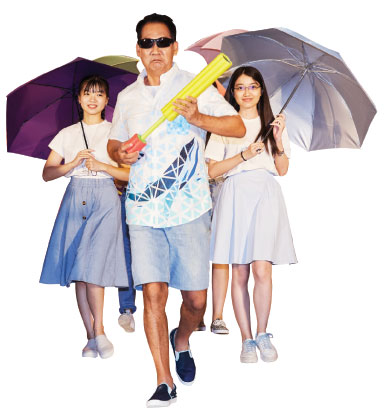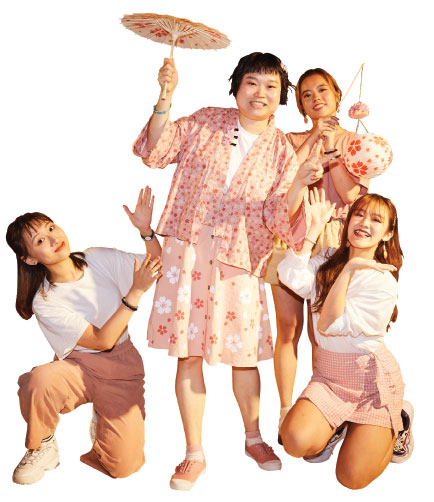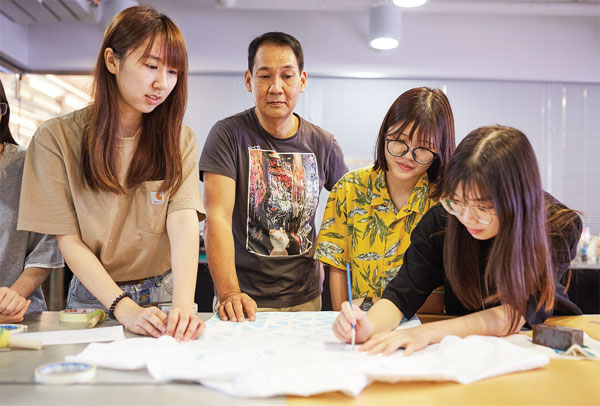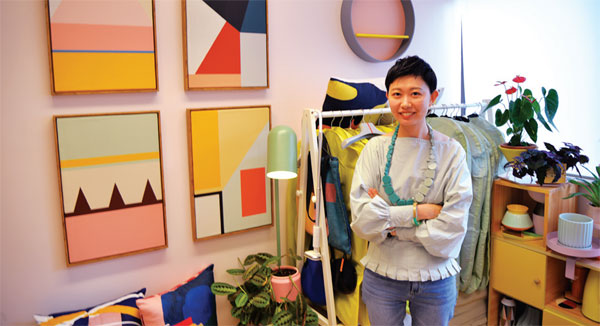Designs for an inclusive society
Updated: 2019-08-30 07:38
By Alex Yu(HK Edition)
|
|||||||||
Alex Yu reports on an effort launched by HK PolyU to use fashion designing as a tool for improving the lives of people with special needs
Fashion, and the design process behind it, can play a deeper role in society beyond making a style statement or building a social media following. In the right hands, it can help heal those suffering from mental health problems and bring out talents that had remained hidden.
Jin Lam, assistant professor at Hong Kong Polytechnic University's Institute of Textiles and Clothing, has seen this happen. Her attempts to connect different vulnerable groups in society and help them find solace through fashion co-design has led to discovering talent where it seemed least likely.

|
W.M. Wong, a volunteer of Hong Kong PolyU's co-designing program, walks the ramp with design students. |
|
Flanked by her designer teammates, See Ying displays her sartorial designs featuring her favorite cherry blossom motifs. |
|
W.M. Wong joins Hong Kong PolyU students in a designing workshop. |
|
Jin Lam plans to involve Hong Kong's elderly people in the co-designing program. |
"I started out reflecting on the nature of my expertise and the discipline of fashion itself, especially in relation to many of my friends who have been suffering from mental issues," says Lam.
"The only advice they received was the suggestion to try a different pill."
Lam found that there was almost no follow-up support offered to mental health sufferers, particularly toward helping them build a social network. It prompted her to design a full credit-bearing course called "Community engagement through expressive textile arts and fashion". She herself was one of the first students on the course in order to test out all the challenges involved. The course is now in its fourth year with Lam as project leader. The latest cohort of 10 first-time fashion designers who worked closely with 10 students with a history of psychiatric problems held an exhibition of their works in July. The experience has been a positive one for the participants and their families, Lam says.
"While those with mental issues were sensitive and thoughtful, the intellectually challenged were all very polite - all of them concentrated so well in class and could not have behaved more differently from any society-given identity labels," she observed.
The 10 intellectually-challenged participants, who were from Hong Chi Association, included an autistic boy who had only ever expressed himself through body movements and expressions. Lam worked with other students in the class to devise creative ways to get him involved in the co-design process.
"My name is Ah Man, and I'm very happy," he said, breaking his silence in front of the camera after his styling photo shoot. The words brought tears to his mother's eyes as it was one of the rare occasions when Ah Man verbalized his feelings.
"That was the moment I realized that my program does offer therapeutic values," says Lam. "Irrespective of backgrounds, participants can improve through fashion. I want to work with organizations from a wider range of backgrounds to develop more effective co-design models."
Finding friends
Another participant, See Ying, who has a mild intellectual disability, worked with four students and painstakingly completed fabric printing by hand. She confidently used her favorite things - such as the color pink and Japanese cherry blossom - in the dress she designed.
"I love dresses," See Ying said in a soft voice. "And my piece is beautiful."
A social worker from Hong Chi Association, Leung, who also attended some of the lessons, recalled how See Ying would call her teammates "leng lui", or pretty girls, and made friends with them in no time.
"It's wonderful how she has been putting great effort not just in making the best possible dress, but also new friends," said Leung.
Another participant, W. M. Wong, had begun to suffer from depression as he neared retirement after a three-decade career working for the emergency services team at the Hong Kong Fire Services Department.
When the bodily symptoms linked to his mental issues became too much to bear, Wong approached New Life Psychiatric Rehabilitation Association for treatment (NLPRA). The healing was fast. Grateful for the support he had received from the experienced psychiatrists, nurses and social workers at NLPRA, Wong decided to volunteer at Hong Kong PolyU's co-designing program. He hopes to come back as an organizer in the program's next edition.
Wong's presence in the next edition might be particularly helpful as through it Lam plans to cater to Hong Kong's elderly people.
"Let's say for an elderly couple living alone, changing diapers can become much easier with trousers opening sideways with user-friendly fasteners - any small, functional design has the potential to improve their living standards," Lam explains.
Keeping in mind how older people often prefer to wear their memory-rich clothes instead of buying new ones, Lam plans to launch a government-sponsored program with a mobile sewing team who will visit elderly people and organize community workshops.
"One's quality of life is determined not just by health and wealth but also one's overall well-being," she says. "We can create a co-design network through textile arts beyond just having fashion in our wardrobes, picking up new skills and connecting different communities at the same time."
(HK Edition 08/30/2019 page9)



